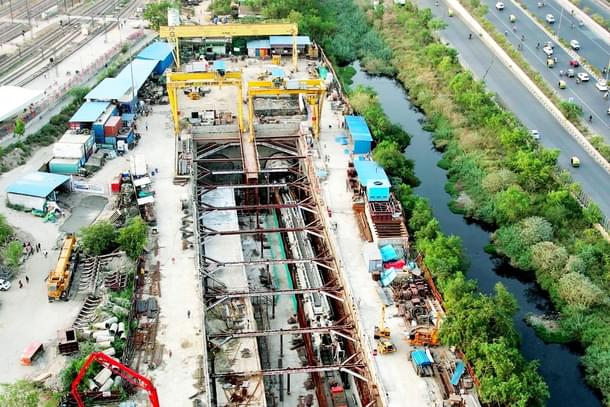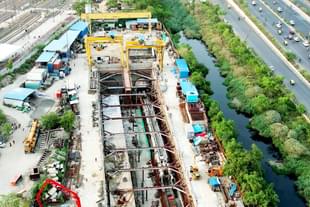Infrastructure
Delhi-Meerut RRTS Project: Tunnel Construction From Anand Vihar To Sahibabad Commences
Arun Kumar Das
Jun 28, 2022, 10:30 AM | Updated 10:37 AM IST
Save & read from anywhere!
Bookmark stories for easy access on any device or the Swarajya app.


A state-of-the-art tunnel boring machine has started tunnelling work in the direction of Sahibabad from Anand Vihar station on the Delhi-Ghaziabad-Meerut RRTS corridor.
Named as Sudarshan (TBM) , two such machines are already working on tunnel construction from Anand Vihar RRTS station towards New Ashok Nagar RRTS station. This is the third Sudarshan (TBM), which has started the construction of a tunnel from Anand Vihar towards Sahibabad.
The total length of this RRTS corridor is 82 km, out of which 14 km is in Delhi and 68 km is in Uttar Pradesh. This corridor has four stations in Delhi, Jangpura, Sarai Kale Khan, New Ashok Nagar and Anand Vihar, of which only Anand Vihar station is underground. From this station, New Ashok Nagar towards Delhi and Sahibabad towards Ghaziabad are being built as elevated RRTS stations.
Two Sudarshan (TBMs) are already working to construct two parallel tunnels of 3 km length from Anand Vihar RRTS station towards New Ashok Nagar. About a 2 km long tunnel will be built from Anand Vihar towards Sahibabad, which will end in front of Vaishali metro station. The launching shaft for the third Sudarshan (TBM) has been made at the north of Anand Vihar RRTS station, from where the construction of the tunnel has commenced.
At the same time, at the end of the tunnel, a retrieving shaft is being built in front of Vaishali Metro Station, from where Sudarshan (TBM) will be retrieved. There will also be two parallel tunnels from Anand Vihar towards Sahibabad for the arrival and departure of trains.
The 17-km priority section between Sahibabad to Duhai will be commissioned by March 2023 and the trial run is expected to commence this year. At present, the civil construction work of the priority section has reached the final stage.
Tunnel rings are made underground by TBM with the help of tunnel segments. Seven tunnel segments are generally used to form a tunnel ring. The tunnel segments are being manufactured at NCRTC's Casting Yard with assured quality control.
Due to the large rolling stock and a high design speed of 180 mph, the width of RRTS tunnels is being constructed as 6.5 m in diameter. Compared to the metro systems, this is for the first time that a tunnel of such a large size is being constructed in the country.
There is a provision for two parallel tunnels for the movement of trains in the underground sections of RRTS. Along with this, various security measures have also been made to ensure the safety of the passengers.
Emergency exits will be made in the underground sections for the safety of the passengers in case of any emergency. A cross-passage would be provided at approximately every 250 metres. The RRTS tunnel will also have ventilation ducts to ensure air movement and a 60 cm-90 cm wide side walkway which will assist in maintenance activities and also act as an additional emergency exit.
For the construction of the tunnels, about 90 meters long Sudarshan (TBM) is being used. This TBM consists of Cutter Head, Front Shield, Middle Shield, Tail Shield, Erector, Screw Conveyor and many other important parts.
Some of the important reasons behind the implementation of this project are to decongest the national capital, reduce vehicular traffic and air pollution, and ensure balanced regional development.
NCRTC is using state-of-the-art technologies to ensure safe and timely completion of works while minimising inconvenience to the commuters, business owners and residents of the entire segment.
One of the techniques being widely used for the project is pre-casting of various civil structures and minimising the construction work on site.
Also Read: Taking Tunnelling In India To Next Level: Challenges And Opportunities Beyond TBMs And NATMs
Arun Kumar Das is a senior journalist covering railways. He can be contacted at akdas2005@gmail.com.





